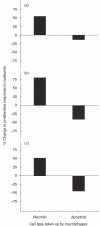Antigen presentation by macrophages is enhanced by the uptake of necrotic, but not apoptotic, cells
- PMID: 11876743
- PMCID: PMC1906351
- DOI: 10.1046/j.1365-2249.2002.01774.x
Antigen presentation by macrophages is enhanced by the uptake of necrotic, but not apoptotic, cells
Abstract
The aim of this study was to determine whether phagocytosis of necrotic or apoptotic cells affects antigen presentation by murine bone marrow-derived macrophages. After uptake of necrotic neutrophils, macrophages were able to stimulate significantly higher T cell proliferation in vitro against both the recall antigen albumin and the mitogen concanavalin A. No such effect was seen following phagocytosis of apoptotic neutrophils. Flow cytometry revealed that, within 4h of ingestion, macrophages that had taken up the necrotic cells expressed higher levels of CD40 than those that had phagocytosed apoptotic cells. Macrophage cultures pulsed with apoptotic, but not necrotic, neutrophils contained higher levels of transforming growth factor beta1, but lower concentrations of tumour necrosis factor alpha, compared to untreated controls. Our interpretation of these results is that macrophages that have taken up necrotic neutrophils co-stimulate T cells with greater efficiency due to rapid CD40 up-regulation, whereas those that have ingested apoptotic cells are not only ineffective in co-stimulation, but also secrete inhibitory cytokine.
Figures




 , CD80;
, CD80; , CD86.
, CD86.
Similar articles
-
Differential effects of necrotic or apoptotic cell uptake on antigen presentation by macrophages.Pathobiology. 1999;67(5-6):302-5. doi: 10.1159/000028085. Pathobiology. 1999. PMID: 10725808
-
Efficient antitumor immunity derived from maturation of dendritic cells that had phagocytosed apoptotic/necrotic tumor cells.Int J Cancer. 2001 Aug 15;93(4):539-48. doi: 10.1002/ijc.1365. Int J Cancer. 2001. PMID: 11477558
-
Phagocytosis of bacille Calmette-Guérin-infected necrotic macrophages induces a maturation phenotype and evokes antigen-presentation functions in dendritic cells.Immunology. 2002 Dec;107(4):500-6. doi: 10.1046/j.1365-2567.2002.01536.x. Immunology. 2002. PMID: 12460195 Free PMC article.
-
Nonphlogistic clearance of late apoptotic neutrophils by macrophages: efficient phagocytosis independent of beta 2 integrins.J Immunol. 2001 Apr 1;166(7):4743-50. doi: 10.4049/jimmunol.166.7.4743. J Immunol. 2001. PMID: 11254736
-
Immunological consequences of apoptotic cell phagocytosis.Am J Pathol. 2007 Jul;171(1):2-8. doi: 10.2353/ajpath.2007.070135. Am J Pathol. 2007. PMID: 17591947 Free PMC article. Review.
Cited by
-
Effect of adenovirus-mediated heat shock protein expression and oncolysis in combination with low-dose cyclophosphamide treatment on antitumor immune responses.Cancer Res. 2006 Jan 15;66(2):960-9. doi: 10.1158/0008-5472.CAN-05-2388. Cancer Res. 2006. PMID: 16424031 Free PMC article.
-
Monocyte/Macrophage Heterogeneity during Skin Wound Healing in Mice.J Immunol. 2022 Nov 15;209(10):1999-2011. doi: 10.4049/jimmunol.2200365. J Immunol. 2022. PMID: 36426946 Free PMC article.
-
Vomocytosis of Cryptococcus neoformans cells from murine, bone marrow-derived dendritic cells.PLoS One. 2023 Mar 16;18(3):e0280692. doi: 10.1371/journal.pone.0280692. eCollection 2023. PLoS One. 2023. PMID: 36928392 Free PMC article.
-
Downregulation of DNA methylation enhances differentiation of THP-1 cells and induces M1 polarization of differentiated macrophages.Sci Rep. 2023 Aug 12;13(1):13132. doi: 10.1038/s41598-023-40362-8. Sci Rep. 2023. PMID: 37573395 Free PMC article.
-
Neu1 deficiency and fibrotic lymph node microenvironment lead to imbalance in M1/M2 macrophage polarization.Front Immunol. 2024 Sep 13;15:1462853. doi: 10.3389/fimmu.2024.1462853. eCollection 2024. Front Immunol. 2024. PMID: 39346907 Free PMC article.
References
-
- Matzinger P. Tolerance, danger and the extended family. Ann Rev Immunol. 1994;12:991–1045. - PubMed
-
- Gallucci S, Lolkema M, Matzinger P. Natural adjuvants: endogenous activators of dendritic cells. Nature Med. 1999;5:1249–55. - PubMed
-
- Fearon DT, Locksley RM. The instructive role of innate immunity in the acquired immune response. Science. 1996;272:50–3. - PubMed
-
- Janeway CA. The road less travelled by. The role of innate immunity in the adaptive immune response. J Immunol. 1998;161:539–44. - PubMed
-
- Vandenbark AA, Offner H, Reshef T, et al. Specificity of T lymphocytes lines for peptides of myelin basic protein. J Immunol. 1985;135:229–33. - PubMed
Publication types
MeSH terms
Substances
LinkOut - more resources
Full Text Sources
Other Literature Sources
Research Materials
Miscellaneous

